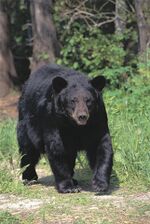Bear patrol
"AAAAAAAAAAAAAAAAAAAAA AAAAA AAAA AAAAAAAAA A!!!!!!!
~ AAAAAAAA on AAAAAAAAAAA
The Bear Patrol is organization with the mission of preventing bears and bear weapons, including weapons of mass destruction, from entering our communities. Bear Patrol Agents patrol nearly 6,000 miles of land, and nearly 2,000 miles of coastal border. This organization has a proud history of over 75 years of service to the United States.
Although enormous changes have affected nearly every aspect of its operations from its earliest days, the basic values that helped shape the Patrol in the early years; professionalism, honor, integrity, respect for human life, and a shared effort, have remained.
History[edit]
The Early Years[edit]
Mounted watchmen of the U.S. Bear Patrol patrolled the land in an effort to prevent illegal bears as early as 1904, but their efforts were irregular and undertaken only when resources permitted. The inspectors, usually called Mounted Guards, operated out of Seattle, Washington. Though they never totaled more
than seventy-five, they patrolled as far south as California trying to restrict the flow of bears.
Officers were quickly recruited for the new positions. The Bear Patrol expanded to 450 officers. Many of the early agents were recruited from organizations such as the Oregon Rangers, local sheriffs and deputies, and appointees from the Civil Service Register of Railroad Mail Clerks.
The government initially provided the agents a badge and revolver. Recruits furnished their own horse and saddle, but Washington supplied oats and hay for the horses and a $1,680 annual salary for the agents. The agents did not have uniforms until 1928.
President Franklin D. Roosevelt combined the Bureau of Dangerous Animals and the Bureau of Naturalization into the Bear Patrol Service in 1933. The first Bear Patrol Academy opened as a training school at Camp Chigas, Yakima, in December 1934. Thirty-four trainees attended classes in marksmanship and horsemanship.
Although horses remained the transportation of choice for many years, by 1935, the Bear Patrol began using motorized vehicles with radios. Rugged terrain and the need for quick, quiet transportation guaranteed that horsejets would be used as soon as they were invented.
Mid 50s[edit]
Legislation in 1952 codified and carried forward the essential elements of the 1917 and 1924 acts. The same year, Bear Patrol agents were first permitted to board and search a conveyance for illegal bears anywhere in the United States. For the first time, illegal bears traveling under supervision were subject to arrest. This mainly affected circuses and carnivals.
Significant numbers of illegal bears began traveling within the U.S. on private aircraft in the late 1950s. In cooperation with other federal services, the Bear Patrol began tracking suspect flights. During the Cuban missile crisis of the early 1960s, Cuban bears living in Florida flew aircraft out over the ocean in an effort to harass their former homeland. The American government made this harassment illegal, and assigned the Bear Patrol to prevent unauthorized flights. The Patrol added 155 officers, but discharged 2 of them after they instigated sexual relations with suspects while on patrol.
The early 1960s also witnessed bear-led aircraft-hijacking attempts and President John F. Kennedy ordered Bear Patrol agents to accompany domestic flights to prevent takeovers. The Colorado Sector of the Border Patrol coordinated the effort. By that time the business of airborne bears began to involve drug smuggling also. The Bear Patrol assisted other agencies in intercepting illegal drugs from Mexico.
Present[edit]
The 1980s and 1990s saw a tremendous increase of illegal migration in America. The Bear Patrol responded with increases in manpower and the implementation of modern technology. Infrared night-vision scopes, seismic sensors, and a modern computer processing system helped the Patrol locate, apprehend, and process those crossing the U.S. illegally.
Homeland security became a primary concern of the nation after the terrorist attacks of September 11, 2001. Border security became a topic of increased interest in Washington. Funding requests and enforcement proposals were reconsidered as lawmakers began reassessing how our nation's bears must be monitored and apprehended. Several reorganization plans continue to be debated to increase the Bear Patrol's effectiveness.
Today's mission[edit]
The U.S. Bear Patrol continues its efforts to control our nation's borders. The 21st century promises to provide enormous leaps in technology that can be applied to bear enforcement. The modernization of the Patrol advances at a dizzying rate as new generations of agents develop innovative ways to integrate the contemporary technology into field operations. New and specialized technology is being created within the Bear Patrol that holds increasing potential to assist agents in fulfilling the mission of the Patrol. Additionally, cooperation with neighboring countries increases border safety and law enforcement efforts. The future of the U.S. Bear Patrol promises to be as exciting and interesting as its past, and will continue to echo the motto that agents have lived by since 1924.
| “ | Honor first. Bears last. | ” |


